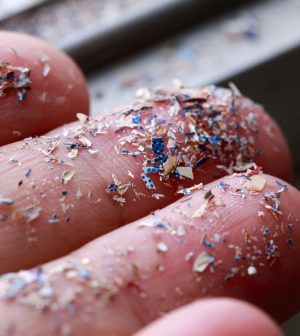- Skip Storing This Everyday Product in the Fridge Door
- Green Tea + B3 Pairing May Boost Brain Health
- Navigating Your Midlife Crisis: Embracing New Possibilities
- City Raccoons Showing Signs of Domestication
- Mapping the Exposome: Science Broadens Focus to Environmental Disease Triggers
- One Week Less on Social Media Linked to Better Mental Health
- Your Brain Changes in Stages as You Age, Study Finds
- Some Suicide Victims Show No Typical Warning Signs, Study Finds
- ByHeart Formula Faces Lawsuits After Babies Sickened With Botulism
- Switch to Vegan Diet Could Cut Your Greenhouse Gas Emissions in Half
Microplastics Found in Human Penises

Seven different kinds of microplastics have been discovered in human penises for the first time.
The tiny fragments, formed when plastic products break down in the environment, were found in four of five samples of penis tissue, researchers reported Wednesday in IJIR: Your Sexual Medicine Journal.
These minuscule particles can infiltrate cells and tissues in major organs. Just last month, researchers reported that startling levels of microplastics had been spotted in human testes.
And Ranjith Ramasamy, lead author of the penis study, told CNN that he used a previous study that found evidence of microplastics in the human heart as a basis for his research.
Ramasamy said he wasn’t surprised to find microplastics in the penis, as it is a “very vascular organ,” like the heart.
The penis samples were taken from five patients who had been diagnosed with erectile dysfunction (ED) and were in the University of Miami’s hospital to have penile implant surgery between August and September 2023.
The samples were analyzed using chemical imaging, which revealed the presence of microplastics in four of the men.
Seven different types of microplastics were detected, with polyethylene terephthalate (PET) and polypropylene (PP) being the most prevalent, researchers said.
What now?
“We need to identify whether microplastics are linked to ED and if there is a level beyond which it causes pathology and what types of microplastics are pathologic,” Ramasamy said.
He added that he hoped the study would “create more awareness about the presence of foreign bodies within human organs and foster more research surrounding this topic.”
In addition, “I think we need to be mindful about consuming water and food from plastic bottles and containers and try and limit the use until more research is done to identify levels that could cause pathology,” Ramasamy said.
Matthew Campen, a regents’ professor of pharmaceutical sciences at the University of New Mexico in Albuquerque, told CNN this is “an interesting study that confirms the ubiquity of plastics in the body.”
“As we are trying to understand the potential health effects of plastics, this is another concerning paper,” said Campen, who wasn’t involved in the research.
“Plastics are generally non-reactive with the cells and chemicals of our bodies, but they could be physically disruptive to the many processes our bodies undertake for normal function, including functions related to erection and sperm production,” he explained.
Campen co-authored the human testes study, which found that human testicles contain levels of microplastics that are three times higher than those found in animal testes and human placentas.
That study tested 23 preserved testes from cadavers of males who were ages 16 to 88 at the time of their death, then compared the levels of 12 different types of plastics in those testicles with plastics found in 47 dog testes.
“The levels of microplastic shards and types of plastics in human testes were three times greater than those found in dogs, and the dogs are eating off the floor,” Campen told CNN when the study was published in May. “This is an eyes wide open situation right now. We’re just now realizing how much plastic is in our bodies. We need a surge of research around this topic to confirm or deny a role for microplastics in driving infertility, testicular cancer and other cancers.”
In the meantime, what can people do to lower their exposure to microplastics?
“One is to reduce our plastic footprint by using stainless steel and glass containers when possible,” Dr. Leonardo Trasande, director of environmental pediatrics at NYU Langone Health, told CNN earlier this year.
“Avoid microwaving food or beverages in plastic, including infant formula and pumped human milk, and don’t put plastic in the dishwasher, because the heat can cause chemicals to leach out,” said Trasande, the lead author for the American Academy of Pediatrics’ policy statement on food additives and children’s health.
More information
Harvard Medicine has more on microplastics.
SOURCES: IJIR: Your Sexual Medicine Journal, June 19, 2024; CNN
Source: HealthDay
Copyright © 2025 HealthDay. All rights reserved.










